Check out what to take into account when choosing the best electric violin for yourself and find out what my recommendations are!
Electric violins come in all sorts of shapes and sizes, and which one is the best electric violin for you will depend on various factors. There is a huge number of makers, with vast differences between brands, but not so much difference within a brand. At first glance, it can feel overwhelming trying to choose.
The most important question you need to ask yourself when looking to buy an electric violin is what you want to use it for. What type of sound do you want? Is it mostly so you can practice quietly or is it for performing on stage? What is your budget? Do you want to be able to use your own chin rest? Do you need a bout or not? (The bout or shoulder of the violin is the place that guides your left hand in higher positions.) Do you want more than four strings? Do you want a funky or understated look? Do you want frets? All these and other considerations are covered in this post as well as my recommendations to make the choice easier for you.
Let’s start with the top of the top among electric violins.
My Top 5 Best Electric Violins
There are 5 electric violins that I can recommend to you if you’re looking for such a type of violin.
NS-CR wins for the best quality thanks to the sound and adaptability (adjustable shoulder rest and bridge, removable bout, different sounds available). The features of this instrument also make it the best electric violin for a stage performance.
The best budget option is Harley Benton HBV 870BK, also best for beginners as it comes with a violin case and accessories, it’s the best value for the money, and it is widely available.
As the most beautiful instrument, I chose Cantini Earphonic Electric/Midi Violin “The King” for its best look among electric violins and best electronic sound.
As the best instrument for silent practice, Yamaha SV-250 is a go-to product. It’s not only best for quiet practice with easy sound control, but also a great choice if you prefer an instrument in a mid-range value.
From acoustic-electric violins, Thomann Europe is my recommendation – the best value for money among this type of instruments and with a “modest” look.
Below you will find a specification for each of these instruments, plus a few more that are worth checking. Before that, let me explain what are the types of electric violins.
You can click here to skip directly to the products’ reviews.
Electric Violin Types
Electric violins come in different types, the following categories are based on how the instrument is constructed and what it can do.
Electric Violin
These are what people usually think of when talking about an electric violin, the sound is entirely based on the electronic signals created by the pickups. These pick up the vibrations from the strings and transmit a signal to an amplifier. The amplifier then sends a signal to the speakers. Along the way, you can add effects, or pass it through a computer for recording and effects on the sound, and finally, the sound is output through speakers. The body of the violin is not involved in the amplification of the sound, nor does it add much to the sound quality. Therefore makers can get quite creative with what shape the violin has, the only limitations are that the product should still be playable by someone who can play on an acoustic violin and it shouldn’t be too heavy. In fact, the lighter the better.
Electric Silent Violin
These are a newer addition to the electric violins on the market, they do everything an electric violin can do, plus have the additional freedom to use it without having to carry an amp around, or having to pass it through a computer. They have their own power supply that runs on either a battery or with a transformer, and you can plug in your headphones directly to listen to your playing.
The electronics is sometimes integrated into the violin body, and at other times it is packed into an external box. Each version has its advantages. The external box makes the violin body lighter, however, the internal packing makes you have fewer cables, so it depends on what you prefer or need.
Acoustic-Electric Violin
This is very much like an acoustic violin, with the added jack outlet and pickups, so you can play it as a traditional instrument, or, using the jack output, you can amplify the sound electronically, like with an electric violin. These hybrids are the best of both worlds, or perhaps best of neither? The body, clearly, has to keep the classical shape (although, some producers break this rule), and the additional electronic parts affect the acoustics of the sound and add to the weight. Also, as these are usually made for the mass market, they will never be as good as some top-end acoustic violins.
Added Pick-up for Traditional Violin
As an alternative to buying an electric violin, if you already have an acoustic one, you could simply get a pickup that has a jack output. These come in different varieties, some attach to the bridge, some to the body, some are simply a small microphone that picks the sound up from the f-holes. This can be an option if you can’t or don’t want to get a whole different instrument.

I personally recommend my students get an acoustic violin and add a pickup later. It will be less expensive and you will probably find an instrument with a better price-quality ratio. It is also more versatile, as you can remove the pickup anytime to transform your violin into a 100% acoustic violin.
I am personally using MiSi Acoustic Trio/Vio pickup with a preamp.
A Note on Passive vs Active Pickups
Electric instrument pickups are called either active or passive. Active instruments come with a built-in pre-amp, while passive ones do not. This will make a difference in the sound output. Passive pickups generally produce a more open sound and are more musically versatile. They also sound more classical or ‘retro’.
Active ones have a more flat, rounded clean sound. They are capable of producing more volume and less unwanted hissing noise. More control over volume and tone as separate qualities. They however require batteries or a power source which means that when your battery runs out, your instrument won’t work. Also if anything breaks in the wiring, your instrument won’t work.
Having said that, active pickups create a much more powerful output, so they are worth the trouble.
The Most Popular Electric Violins
The following are a selection of electric violins, electric silent violins, and acoustic-electric violins on the market that I recommend, based on my own experience, reviews, and reports from many players, both amateurs and professionals. I will also look at parameters such as weight, ability to access the higher end of the fingerboard, mobility, and more.
Yamaha SV-250 Electric Silent Violin
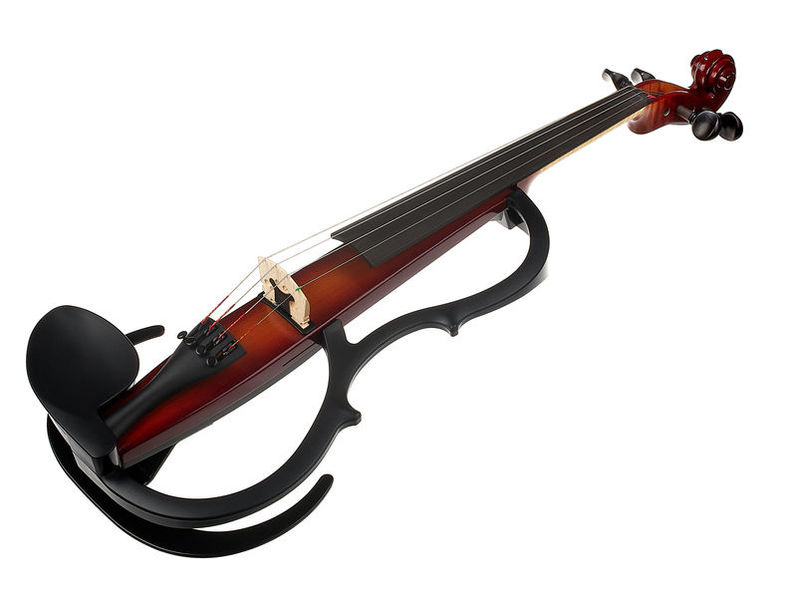
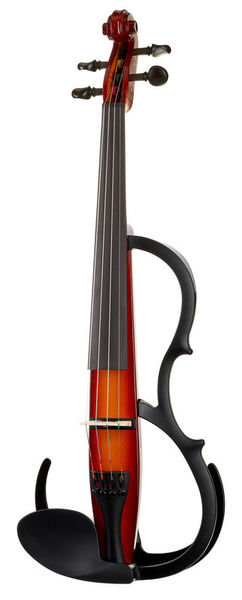
SPECIFICATION
Price: £1,699/€1599/$1,825.77
Materials: Spruce/Maple body, Ebony fingerboard, Plastic frame
Strings: D’Addario Zyex
Weight: 500g (1lb, 1oz), Control Box: 260g (9 oz)
Pickups: 2 Piezo Pickups (Body and Bridge)
REASONS TO BUY
+ Excellent clean sound quality
+ Two pickups
+ Can use headphones
+ Extra controls on your body
+ Trustworthy brand
+ Can attach your regular shoulder rest
REASONS TO AVOID
– Cannot change the chin rest
– Have to carry a control box on your body
– No instructions on how to connect to the computer
– Expensive
Let’s start with Yamaha products, which I personally prefer. The SV-250 has improved sound quality compared to the earlier model, SV-130, and can be connected through your computer for use with unlimited special effects.
The great invention of so-called ‘silent’ violins is that they can be played without an amp, just through headphones, and even though they are not completely silent, they are pretty quiet for practicing.
SV-250 comes with two built-in pickups, one in the bridge and one in the body, and a knob on the back of the violin to choose whether you want to use one or the other, or a mixture of the two.
There is a control box with a power supply, jack cable, and headphones. The control box is hung onto your belt, which can be both a pro or a con. You plug the headphones into it, or the output jack that goes to your amp. The box itself has some controls on it, so you can adjust the volume, treble, and bass, plus a few other things.
It even comes in a 5-string version, the SV-255, should you need that extra string.
It is equipped with D’Addario Zyex strings, which are generally good strings, but some people have found that replacing these makes the sound even better.

Yamaha SV-250 Electric Silent Violin
Support us for more FREE content No extra costs for you Recommended by Violinists
Yamaha YEV-104 TBL Electric Violin

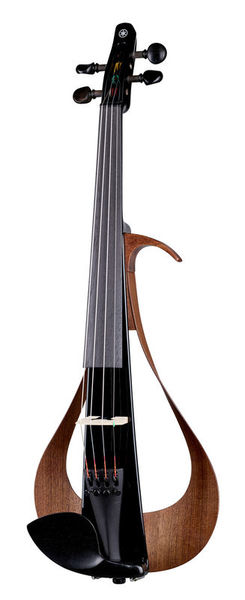
SPECIFICATION
Price: £733/€701.80/$762.47
Materials: Spruce, mahogany and maple
Strings: D’Addario Zyex
Weight: 550g (1lb, 3oz)
Pickups: In the bridge
REASONS TO BUY
+ Fantastic open sound
+ Lightweight
+ Switch between passive or active output
+ Reasonable price
REASONS TO AVOID
– Only one pickup
Couldn’t really find any reason to avoid this violin. While it doesn’t have the choice of two pickups and therefore the ability to adjust the sound depending on what type of music you play, nonetheless it sounds great, and you don’t have the cumbersome external box to contend with. It also looks amazing. The body is shaped similar enough to a regular violin, including bout, so you don’t have to adapt or relearn your higher positions. Should you wish to go wireless, the adapter (to be bought separately) plugs straight into the back under the neck, totally out of sight.
This is a great violin and much more affordable than the SV-250. As long as you don’t need it for quiet practice, go for this. Even the wireless transmitter can plug into the back like it was meant to.

Yamaha YEV-104 TBL Electric Violin
Support us for more FREE content No extra costs for you Recommended by Violinists
NS Design CR4-VN-AM Electric Violin – 4 String Unfretted
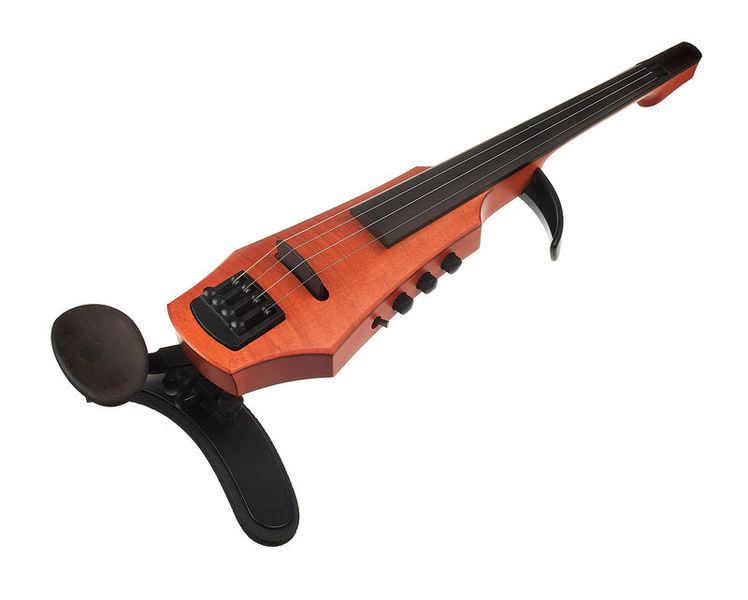
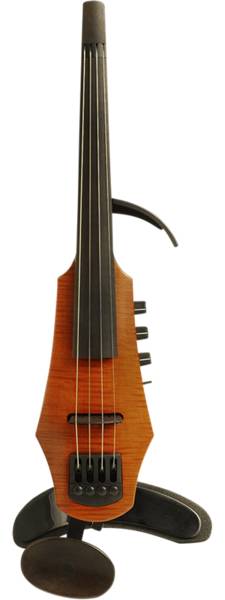
SPECIFICATION
Price: £3,499/€3,145/$3,419
Materials: Straight grain quarter-sawn solid European maple body and
neck, with a flame maple face, ebony fingerboard
Strings: D’Addario™
Weight: 720g (1lb, 9oz)
Pickups: The Polar directional piezo pickup system
REASONS TO BUY
+ Beautiful sound, closest to acoustic
+ Easy to move around with
+ Adjustable height bridge
+ Switch between different sounds
REASONS TO AVOID
– Very Expensive
– No choice of colors or finishes
This is simply a great electric violin. NS violins come in several different varieties, but overall the CR series is the best. Each version comes in four options, 4 or 5 strings, and fretted or unfretted. They all have the same Polar Pickup System, a Self Clamping Tuner System, a Malleable Custom Shoulder Rest, and an adjustable height bridge.
The shoulder rest can be bent with your fingers to almost any shape, overall it’s incredibly versatile in what you can adjust and the sound can be switched instantly between a near classical acoustic sound to the sounds of an electric guitar what makes it one of the best electric violins on the market.
Even though the design is minimalist, the instrument has a bout to help you navigate the fingerboard. This can also be removed if that is what you’d prefer.
The jack output hole is on the back, not the side, which means the cable is less in the way, or if you use a wireless connector, it won’t stick out.

NS Design CR4-VN-AM Electric Violin – 4 String Unfretted
Support us for more FREE content No extra costs for you Recommended by Violinists
Cantini Earphonic Electric/Midi Violin “The King” 4 Strings
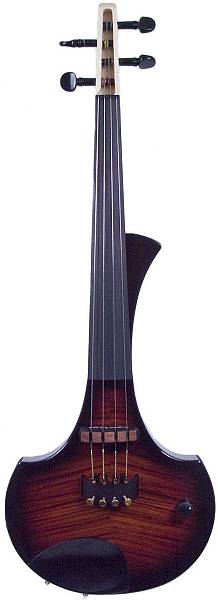


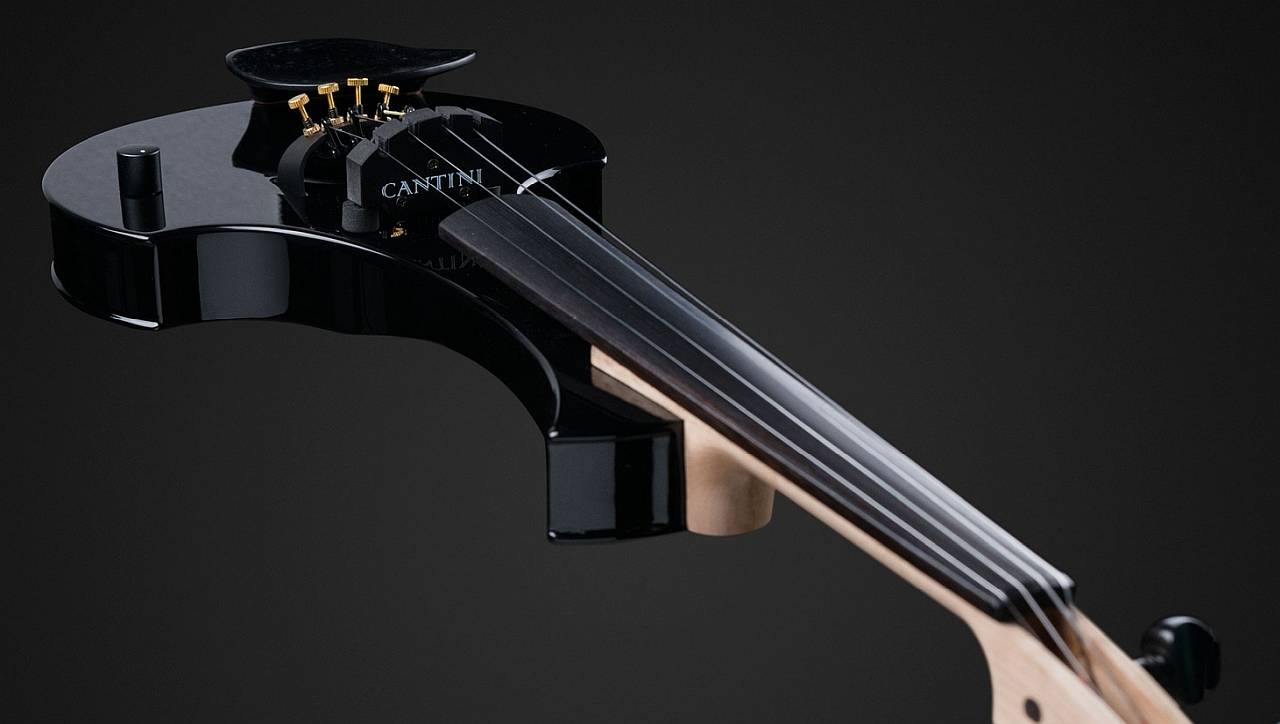
SPECIFICATION
Price: €1720/$1550
Materials: Maple body and neck, ebony fingerboard
Strings: All steel strings are compatible
Weight: 650g (1lb, 7oz)
Pickups: Inductor Separate Sensor Pickup (ISSP2)
Separate magnetic pickup for each string
REASONS TO BUY
+ Great sound
+ Looks fantastic, yet simple
REASONS TO AVOID
– Limited availability
– Expensive
– Midi compatibility limited
Created by Carlo Cantini, these beautiful violins sound amazing. The separate pickup under each string provides a balanced output for the sound.
They come with both MIDI and standard Jack output, but the MIDI is not compatible with the standard 5-pin socket, only the Roland GR-55 synthesizer.
The sound is clean, however not the most natural one. It is more in the electronic range, which, if that is what you’re looking for, is amazing. If you prefer a natural sound, this wouldn’t be the right choice for you.
You can buy it on the producer’s website: www.cantinielectricviolins.com.
Wood Violins Viper 4/5/6/7-String Fretted Electric Violin
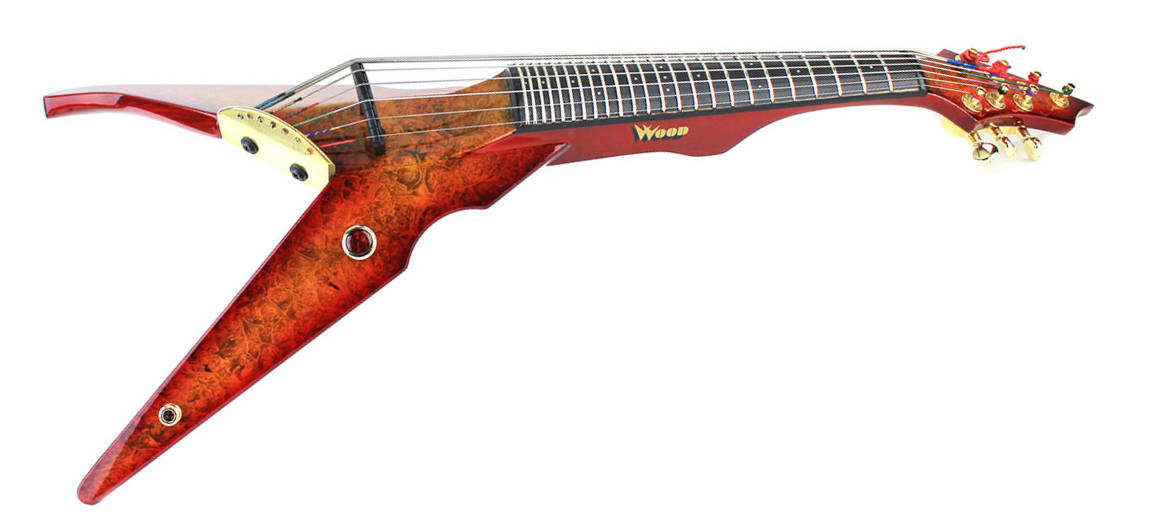
SPECIFICATION
Price: $3000-$5000
Materials: Poplar body, Ebony fingerboard
Strings: D’Addario
Weight: Light, exact weight not specified
Pickups: Wood Tru-Tone or Barbera
REASONS TO BUY
+ Geared tuners
+ Chinrest-free design: strap + chest support
+ No bout, easy access to higher end of fingerboard
+ Extraordinary look
+ Custom Viper violin gigbag included
REASONS TO AVOID
– No bout, might be hard to play at first
– Very expensive
Time for the most extraordinary electric violin: the Viper. This is the only violin that I know that doesn’t require a chinrest. Although the price is extremely high, you may consider this instrument if you are experiencing problems with your neck.
It will be also a great choice for you if you are looking for an instrument for experimenting with the music – the version with 7 strings will give you the most freedom for that!
You can find both a fretted and fretless version of Viper. Frets will help you with having good intonation but they are so shallow that you can still do vibrato and slides. Learn more about fretted violins over here!
You won’t be able to put Viper in a regular violin case but luckily it comes with a custom bag.
Harley Benton HBV 870BK 4/4 Electric Violin
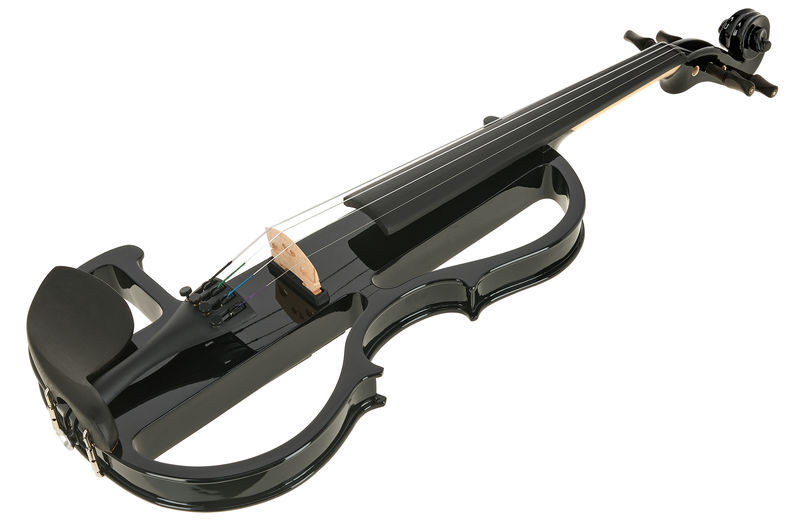
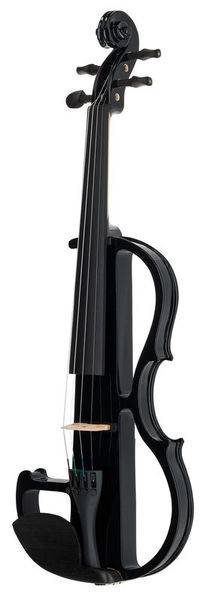
SPECIFICATION
Price: £109/€129/$125
Materials: Body made of Paulownia,
Fingerboard, pegs and chin rest made of Birch
Strings: Not specified
Weight: 700g (1lb, 8.7oz)
Pickups: Shadow Electronics
REASONS TO BUY
+ Very good value for money
+ Includes case, composite bow, rosin and 9 V battery
+ Can use headphones directly
+ Good for quiet practice
REASONS TO AVOID
– Bow, strings and cable of low quality
– Overall low quality
– A little heavy
This is a very affordable electric violin, a good beginner violin kit, includes a case, composite bow, rosin, and 9V battery.
The strings and the cable that come with it are cheap and are better replaced. The same can be said for the bow, which feels unbalanced and heavy. You’re better off with a carbon fiber one. However, these issues are all easily fixed. You do have to consider though that this will add to the overall price.
One reviewer did have a problem with his tailpiece, that came off and he had to glue it back on, but this doesn’t seem to be a regular occurrence.
The only real thing I didn’t like was that it’s slightly on the heavy side. Not too much, but it can create issues with being able to play for extended periods.
The sound is quite good for a budget electric violin, and overall this one is not a bad buy. It is also easily found all around the world.

Harley Benton HBV 870BK 4/4 Electric Violin
Support us for more FREE content No extra costs for you Recommended by Violinists
Jordan Electric Violin
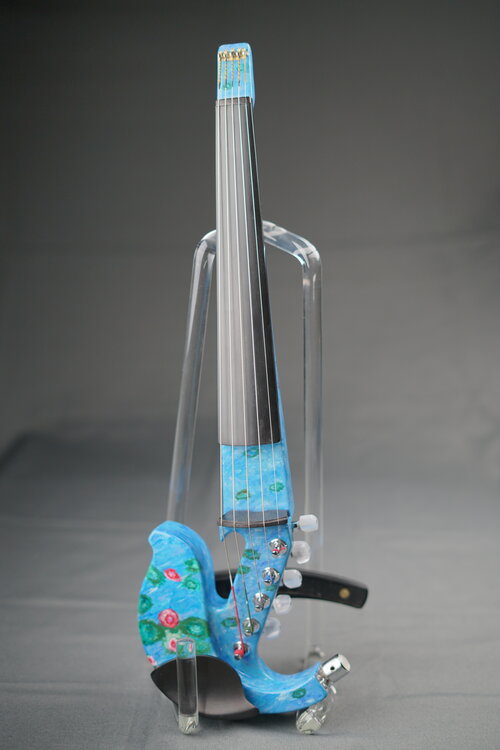
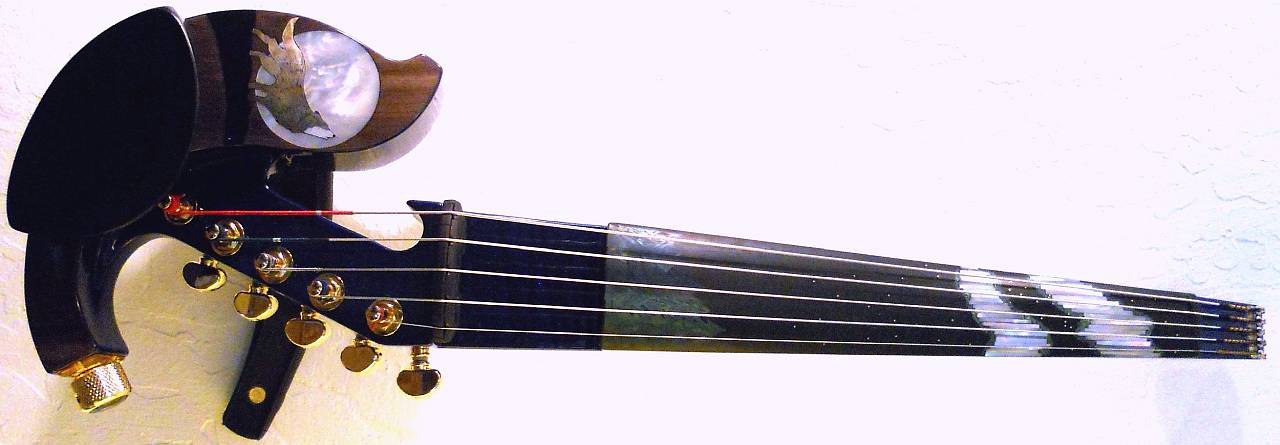
SPECIFICATION
Price: from $2280
Materials: Maple body, ebony fingerboard, all customizable
Strings: Super-Sensitive Sensicore Strings
Weight: Not specified
Pickups: Transducer bridge
REASONS TO BUY
+ Great sound
+ Complete customizability
+ Beautiful look
+ Can have up to 7 strings
REASONS TO AVOID
– Very expensive
– Limited availability
One of the most nicely looking brands, the finish on the body is unique and stands out without a doubt. You have a choice whether to have open access to the fingerboard or you can attach a bout.
You can choose from 4, 5, 6, or 7-string, right-handed or left-handed, fretted or unfretted, a multitude of colors, patterns, and finishes, you can change the inbuilt chin rest and shoulder rest to have them use your preferred ones. You can even change the wood the instrument is made of.
There is complete customizability, though this will of course change the price you pay in the end.
Some things on this violin are quite unusual, like the tuning pegs are at the near end close to your chin, the other way round from a regular violin. This helps keep the neck shorter, and therefore feel of the violin is lighter.
These violins are not widely available but you can find them e.g. in the Electric Violin Shop (www.electricviolinshop.com).
The Best Acoustic-Electric Violins
Mezzo-Forte Carbon Fiber Evo Line Acoustic Electric Violin
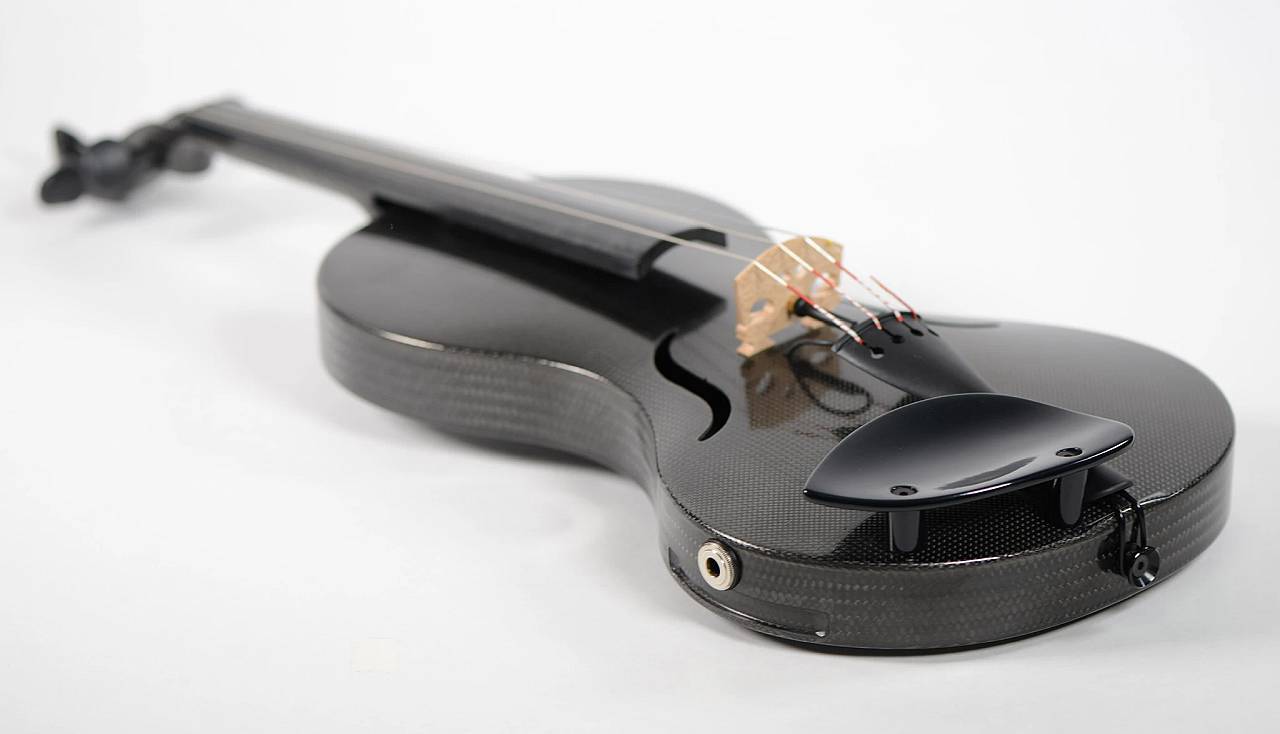

SPECIFICATION
Price: $1,370
Materials: Carbon fiber body, Spruce fiber composite fingerboard
Strings: Pirastro Tonica or Maker’s choice
Weight: 540 grams
Pickups: Passive pickup
REASONS TO BUY
+ Responsive play
+ Clean, deep sound
+ Elegant look
+ Fine tuner pegs
REASONS TO AVOID
– Very limited availability outside the USA
The acoustic sound is really good, bright, and clean. Considering it’s a semi-acoustic violin, it is good middle-range quality, meaning it is as good as you’ll get for this price an acoustic violin. Its bright resonant sound is perhaps a little sharper than your normal violin, as the body is made from carbon fiber, but it doesn’t make it worse, just different. It is very responsive, meaning it is easy to get the sound come out of it.
The acoustic-electric version of this violin is simply the acoustic violin with an added pickup that is integrated into the bridge, and connects to a Jack on the left side of the violin, meaning the cable will hang down your back. This is a good position for it, as the weight of the cable, instead of pulling the violin down, will help you keep it on your shoulder.
The electric sound is simply an amplified version of the acoustic sound, and it sounds equally good. As it is a passive pickup, there are no batteries or tone and volume controls, however, you can add effects and other sounds by connecting it through a pre-amp. You can also use that to route the sound through to the computer.
It is fitted with Wittner fine tuner pegs, which eliminate the need for fine tuners.

Mezzo-Forte Carbon Fiber Evo Line Acoustic Electric Violin
Support us for more FREE content No extra costs for you Recommended by Violinists
Thomann Europe Electric Violin 4/4 NV
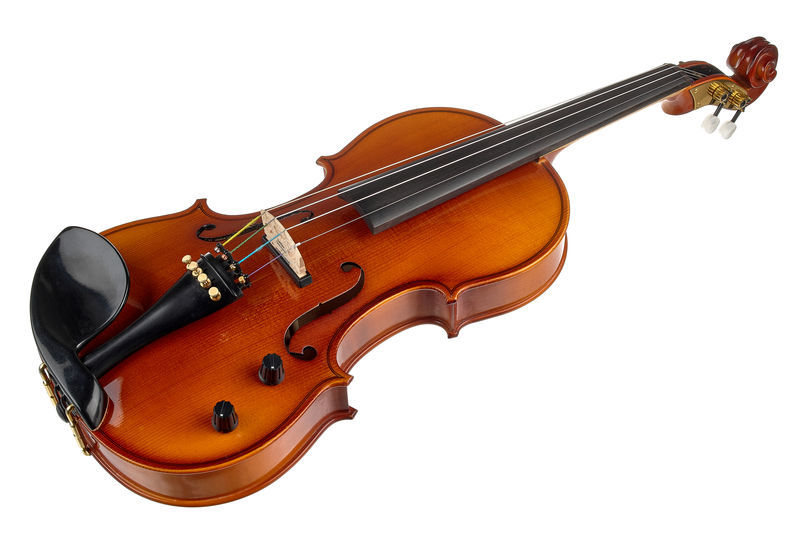
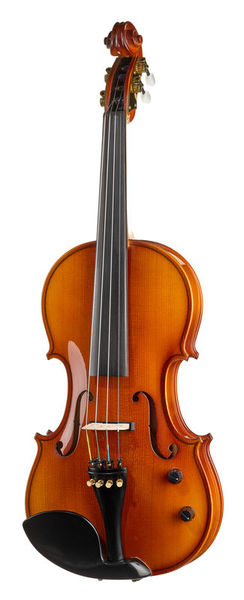
SPECIFICATION
Price: £345/€403/$438
Materials: Spruce top, Maple sides and back, Ebony fingerboard
Strings: Thomastic Dominant
Weight: Not specified
Pickups: Integrated Piezo Pickups
REASONS TO BUY
+ Great value for money
+ Clean and warm sound, also as acoustic
+ Clear tuning
+ Choice of three colours
REASONS TO AVOID
– Cheap strings
– No pegs, mechanical worm gear mechanism
– lacks depth on base acoustic notes
This is overall a great violin for this price. It sounds good both as an acoustic violin and as an electric one. At this price, it may be the best acoustic-electric violin for beginners. The sound can be made even better by upgrading strings e.g. to Corelli.
It is only slightly heavier than an acoustic violin, which makes it quite playable. It’s not as light as an expensive electric violin, but I wouldn’t expect it to be, as it has the full acoustic body, plus some added electronics.
If you want to perform in a loud band, it may not work, as the sound output isn’t powerful enough. Perhaps it has to do with the pickups. But for home use, or for smaller bands, it would work quite nicely.
Comes in natural wood color, black, and white. Includes tone and volume control knobs on the body.

Thomann Europe Electric Violin 4/4 NV
Support us for more FREE content No extra costs for you Recommended by Violinists
Other Brands That Produce Electric Violins
Let me add a few words about other electric violin brands. You may want to also check some of them in your pursuit to find the perfect electric violin for your needs.
Stagg, cheap and cheerful electric violins. They are generally on the heavy side, which can be difficult to play without it compromising your posture. I would avoid them.
Bridge, electric violins with amazing finishes, if you want to stand out in a crowd.
Zeta, both acoustic and electric violins, also make other instruments.
Aurora, Classic, or Wood series – great looking, great sounding violins, starting around $1300.
Cecilio is a recommended brand for beginners, they make good quality budget violins.
Bridge, Wood Violins, Glasser also make acoustic-electric violins.
FAQ
Is it OK to Learn on an Electric Violin?
It is ok to learn on an electric violin, especially when you need to be quiet, but it is not recommended to use it as your primary instrument. As you are developing your ear, it is better to learn on a good-quality acoustic violin – an instrument that is capable of depth and nuanced expression, which will help you discern subtle things.
It is fine to also have an electric violin for fun and occasionally switch them up but even if you have the best electric violin, it will limit your development as a violinist.
If you don’t have your first violin yet, check out my best tips for buying a violin.
Is the Electric Violin Easier?
The electric violin can be considered easier than an acoustic violin in some aspects.
For Recording Music
For recording music, it is much easier to use an electric violin, as you can plug it into the computer and have the sound go straight to your recording software.
For Playing
To play the electric violin, may seem so superficially, and I believe this is because certain subtle things, that would be heard on an acoustic violin may not make a difference on an electric one, so it’s easier to produce a nice sound.
However, this nice sound will never reach the subtlety and depth of the sound of a really good acoustic violin. So it’s a trade-off.
Also, there are many things you can do with an electric violin that you can’t do with an acoustic one, e.g. adding reverb or changing the sound.
Does an Electric Violin Sound Better?
Whether an electric violin sounds better than an acoustic violin depends on a few factors, including the sound effect that you want to create with your playing and your skills in playing.
Subtlety and Depth
Acoustic violins, especially the better ones, have a cleaner, clearer sound than electric violins, even the really good electric ones. They are capable of more nuance, subtlety, and depth in their expression. If you’re playing complex classical pieces, they may not work very well on an electric violin.
More Variety of Sound
However, we are not comparing like with like. Because the reason we use electric violins isn’t to reproduce the acoustic sound but to be able to create different sounds.
To be able to apply effects, to amplify the sound, to do all sorts of things we could never do on an acoustic violin, so an electric violin is better in this case.
If you’re looking for a variety of sounds, if you want to play on stage with amplified sound, in a band, then an electric violin is better for this. And if you want an electric violin that also has quality sound, there are some on the top end of the market that will deliver this also.
What is better ultimately is up to you to decide, depending on what it is you want to achieve.
Are Electric Violins Silent?
No, electric violins are not completely silent. Electric violins still have a body, usually made of solid wood. This means that the vibrations from the strings get somewhat amplified and this creates a sound. So generally speaking electric violins still make a sound.
Even if you just had a string by itself that vibrated, it would still make a sound, though not much. The Yamaha Silent Violins come close, but even they are not completely silent.
How Much is a Good Electric Violin?
A good electric violin costs a few hundred US dollars up to $5000. You can get a fairly good basic one for a bit more than $100, while if you want something fancier and you can afford it, you might want to fork out some more money.
The best quality electric violins, and therefore most expensive ones are still a great deal cheaper than top-level acoustic violins.
Are Electric Violins Worth it?
Whether electric violins are worth buying depends on what you want. If you just want to practice silently, and $100 is not much for you, then yes. If you want to perform, where you need amplified sound, but can’t afford even $100 and you already have an acoustic violin, then you may want to get a pickup only.
If you can afford something in the range of $1300 to $2000, you will get a very nice electric violin, that you can use in most situations.
If you don’t need to be either silent nor perform live in a rock concert, then you don’t really need one. Then it is something you may want just for the fun of it and for being more creative with your music. In such a case, it is always worth spending your time and resources on something that makes you feel happy!
Can You Use Regular Violin Strings on an Electric Violin?
Usually yes, regular violin strings can be used on electric violins. However, some electric violins will come with instructions telling you what type of strings can be used on them, and often they need all-metal strings. So if your electric violin cannot take all types of strings, this should be specified in your instruction manual.
Acoustic-electric violins can use any strings a regular acoustic violin can use. If you need instruction on how to change violin strings, here is my post about it!
Does an Electric Violin Need to be Tuned?
Yes, electric violin needs to be tuned exactly the same way as an acoustic one. Most electric violins come with standard pegs that work in the same way as on an acoustic violin. Some, however, use a mechanical worm gear mechanism you would find on electric guitars.
The geared pegs called tuners are less temperamental than wooden pegs but have a more mechanical feel. This may affect the sound of an acoustic instrument.
Do You Need Rosin for an Electric Violin?
Yes, you need rosin for your bow, no matter if you play on the electric or acoustic violin, and you can use the same bow for both types of violin. Rosin makes the bow have more friction, which makes the string vibrate. Without rosin, your bow would just slide along the string without making any sound.
What Do You Need for an Electric Violin?
For an electric violin, you need the same accessories as for an acoustic violin: bow, rosin, duster cloth, violin case, and a music stand. A shoulder rest is optional as it can be built in the electric violin or not needed in some cases. If you have all the accessories for your acoustic violin, you don’t need to buy a second set.
Some electric violins come as a whole pack so you won’t need anything extra. However most of them, especially the better ones, come as the violin only, so you will need to buy the accessories separately e.g. a violin case.
The beginner packs come ready with everything, including a case, a bow, and even rosin. These are convenient, but often at the expense of quality. Even if the violin is good, the bow can often be cheap, therefore of low quality, and you might be better off using a better bow.
Final Thoughts
As you have probably realized by now, there isn’t one ‘best electric violin’. What is ‘best’ depends on you, your needs, and your creativity. There are many really good ones on the market, and not enough opportunities to try them all out. I hope this article helps you to decide whether to buy an electric violin and which to consider when looking for the best option for you.
If you are about to buy your first violin, make sure to check out my article “How to buy a violin” and download the buying checklist and the violin size chart:
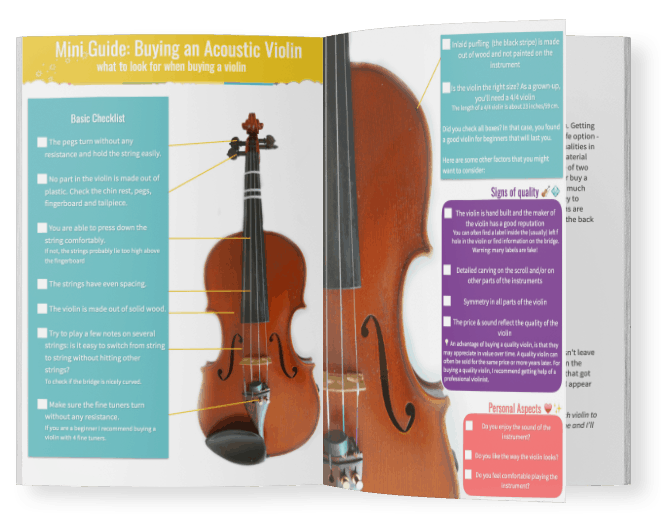
Get Your Free
Violin Buying Checklist [PDF]
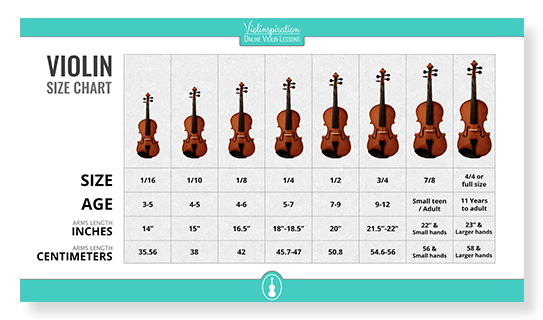
Get Your Free
Violin Size Chart [PDF]
























